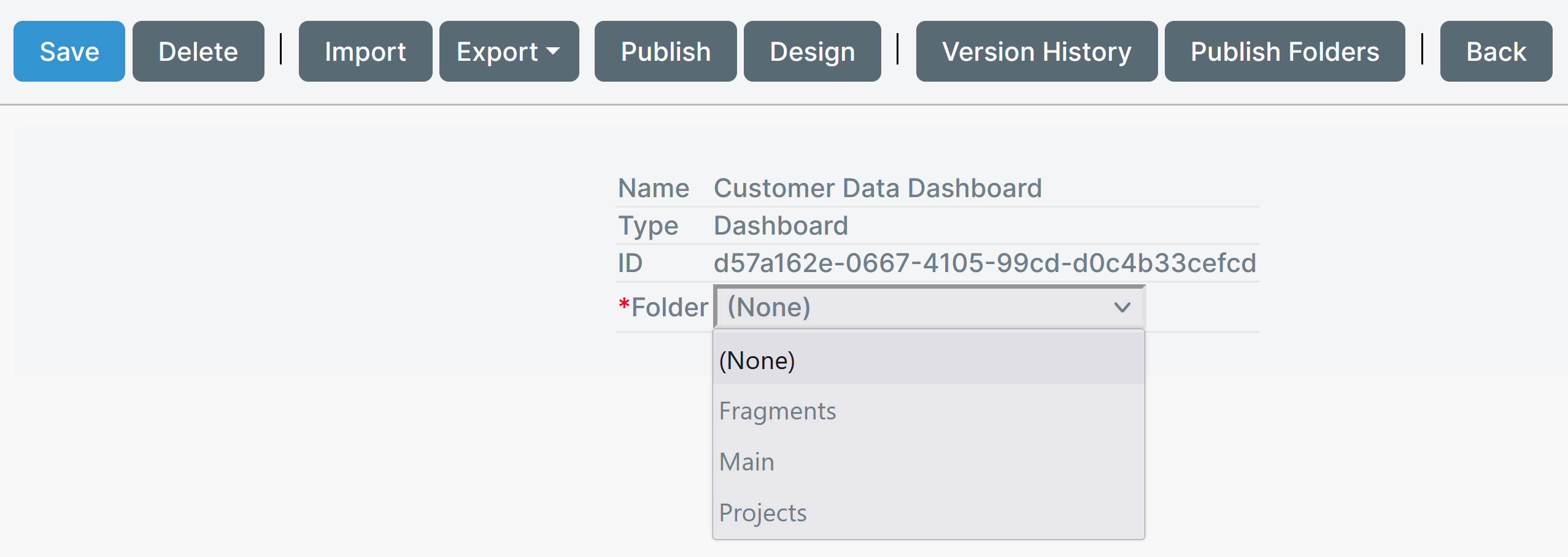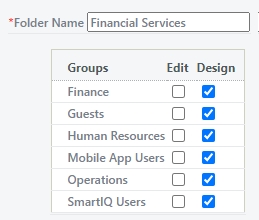Projects
Project Folders contain the Projects currently saved, and provide a way of organizing and controlling edit-ability of projects, data connections, and content items. The (None) folder is a valid folder. Projects with a padlock icon  next to their name are published projects.
next to their name are published projects.

New folders can be added freely but the folder names are limited to 50 characters in length. The search function "Name" accepts % as a wildcard, e.g. "%min" will return any project names that contain 'min'.

Project Folders vs Publish Folders
Project folders differ to Publish folders in that Project Folders control which users can edit or Design with content as opposed to running it in Produce.
Clicking on a project name gives you a number of controls to manage the project.

| Option/s | Description |
|---|---|
| Import and export | Import and export files that contain projects and Sync packages which can be re-imported later. |
| Publish | Publishes the project to the produce app |
| Design | Takes you straight to the design app loading the project |
| Version History | Lists the version number, modification/save date, what user made the last save, their comments, and a version rollback feature |
| Publish Folders | Lists the folders the project is published in |
| Folder | Allows you to set what folder the project is contained within |
Project major and minor versions
Each save to a project in Design represents a minor version, whereas a major change is defined as when the project is closed and the designer is prompted for version comments (optional).
Project Permissions
Different folder permissions can be set for different Groups of users, which apply to anything in a content folder including Projects, Data Connections and Content Items.
Projects, Content Library, and Data Connections share folders and folder permissions
These folders are known broadly as 'content folders'
Clicking the desired folder then 'edit folder' presents the option to enable/disable the Edit and Design permissions for the user groups. This can include different permissions for child folders, however a child folder cannot have a permission that a parent folder does not have.

Edit permission allows that group to see the folder and edit, delete, and create items in that folder.
Design permission allows that group to open existing projects in Design, see and access data sources, fragments and other content items in Design drop down lists to choose from.
Exporting and Importing Projects

Export Project
Exports project contents including Fragments, Data Connections and related Content Library items into an .ixpkg file.
Export Sync Package
Export sync package will call the admin API sync export and create an .iqpkg with the returned JSON. The .iqpkg file has the same contents as the .ixpkg file but also includes information related to the project, how it is interconnected and creates the folder structure; Folders (and their permissions), Groups (and their permissions), Custom Fields definitions, Communication Templates, Sequences, and Approvals.
Import
Importing an .iqpkg file presents a read only view of the project name, with optional import overrides. The import options are the same as the admin API import options: Always, If Not Exists, and If Newer.
Importing a project to different locations will produce slightly varied results:
- Importing to a folder will copy the GUID from the .iqpkg file if that GUID isn't already in use.
- Importing to a project through the edit screen will override the project but keep the original projects GUID.
After importing the project, Manage validates the package by running it through the test API import feature and will only commit the changes if successful.
Attempting to import a sync package into an environment that already has a range of projects, groups, folders etc already configured is not likely to work
Ensure that you are logged in using an account with appropriate permissions
If the user does not have access to any part of the sync package, the import will fail

Updated 11 days ago
